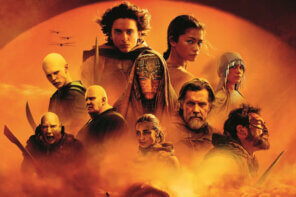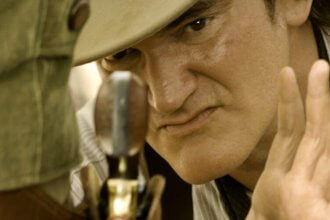Here we are again – another exciting Oscar race. While everyone else has moved on to a new year, we’re still living in the past. At Cinema Faith, the year isn’t over until the cream of the crop brings home the gold.
This year’s Oscar season comes mired in controversy. Many prominent members of the Academy have expressed outrage over the lack of African-American talent represented in the nominations. All of the actors nominated for an Oscar are white this year. Coincidence? Critics say otherwise by pointing out that 94% of Academy voters are white too.
I applaud the cry for diversity. After all, isn’t that what makes film great? Movies transport us into another world. The more diverse the artists, the more exciting the experience becomes. Where else but the movies can we journey from the streets of Compton into the mind of a 12-year-old girl?
Straight Outta Compton and Inside Out are just two of the unique film experiences from 2015. Both nominated for Oscars, but in lesser categories than they deserved. Sure, the Oscars don’t always get it right. But this ceremony is bigger than nominees and winners. The Oscars are a celebration of film itself. Everything about the night is larger than life, just like a night at the movies.
And when all is said and done, the Oscars get more right than they get wrong. Last year’s Best Picture winner was indeed the best film of 2014, and the best movie of 2015 is nominated for every major award. Which film is that, you ask? You’ve come to the right place.
Welcome to part one of our Oscar picks for the big show. These aren’t the movies that will win, these are the movies that should win. Tune in with us on February 28th as we join the world in celebrating another magical year in film.
Best Adapted Screenplay

The Big Short
Brooklyn
Carol
The Martian
Room
Let’s get my bias out of the way up front. I don’t think The Martian deserves a nomination for anything. But if I had to nominate it for something, I’d pick Best Adapted Screenplay. A good chunk of the entertainment value can be traced back to the script. Yet, like the rest of the film, this is B-grade material and far from Oscar-worthy.
Room is one the best films of the year, but I’m not sure the script is the highlight. This is a film that works best when no one is talking. The visceral elements draw us in. The exchanged glances between mother and son, the shots of the sky window, the first burst of the world Jack feels when he slides out from the rug. There isn’t a false note to be found in the writing, but the feelings linger most.
Brooklyn and Carol feel similar in many respects. They’re both extremely polished scripts with lines that make you stop and ponder. Carol turns to Therese at one point and says, “What a strange girl you are. Flung out of space.” There are so many layers to that line. The beauty of both scripts is in the subtext. The two films are about homesickness; literally in the case of Brooklyn and figuratively in the case of Carol. The characters are longing for a home they can never have. The words they say are beautiful, but the meaning underneath is what tantalizes. That’s what great screenwriting is all about.
If for no other reason, the script for The Big Short deserves an Oscar because it finally explains the 2008 mortgage crisis in a way that makes sense. I’ll never forget Jeremy Irons asking Zachary Quinto in Margin Call to explain the problem to him like he’s a child. I leaned forward in my seat hoping that maybe, at last, I would understand was going on, only to slump back again in frustration as the explanation left me even more confused.
The Big Short is like a public service announcement. In the most entertaining way possible, every term of the mortgage crisis is explained with crystal clarity. And for the first time, because we finally understand, we’re filled with outrage. Did this really happen? Will it happen again? But the film is much more than just information. This is a fast-talking, rat-a-tat, blitzkrieg of a script; with a tone that’s both funny and sad at the same time. Words are what slay us in The Big Short, and that’s why this script deserves the gold.
Best Original Screenplay

Bridge of Spies
Ex Machina
Inside Out
Spotlight
Straight Outta Compton
Truth be told, I think the script is the worst part of Ex Machina. The film works because of incredible visuals and haunting performances, but the dialogue lacks precision. This is especially evident in Oscar Isaac’s character Nathan. We’re supposed to be listening to a genius, but when he talks he sounds like a frat boy. Nathan is great at starting conversations, but just when things get interesting he whips out his trademark “Dude!” Maybe this was intentional. To me, it felt like a cop-out.
This is the only nomination for Straight Outta Compton. What an insult. I’m not saying the movie should be a Best Picture contender (though it’s superior to The Martian, Fury Road, and Spotlight), but the film’s raw power lies in its acting and music. I don’t remember a stand out line from the movie. What I remember is Ice Cube standing on a stage ready to fight the world with a song. The Academy needs to modify their music categories. I agree with Jamie Foxx – this was the best score of 2015.
I don’t think I’m alone in my bewilderment at the Oscar love for The Martian, but I may be for Spotlight. I heard nothing but praise going into the film, and I’ve heard nothing but praise since. And yet, the movie left me cold. I don’t think the script is the problem, but it also didn’t help. This is a solid movie across the board, but I would hesitate to call it special.
One of the best written scenes of last year was from Bridge of Spies where Tom Hanks’ character, Donovan, explains why his insurance company should only be involved in one lawsuit even though his client hurt five people. It’s one of those moments where you consciously admire how clever the dialogue is – two actors shooting lines back and forth, the situation growing more ridiculous by the minute. By the end of the exchange, we’re sold on Donovan the salesman, which is so crucial for the story that follows. The scene arrives early on in the script, and the most surprising part is the best is yet to come.
Inside Out should be nominated for a dozen more Oscars, including Best Picture. Sadly, the film only has two – Best Animated Feature (which it will win in a landslide) and this one. I’m not sure if the script can take the trophy, but in a category entitled Best Original screenplay, it should. Inside Out is as original as films come. The genius of Pixar is the way their outlandish premises feel more real and honest than the average story set in reality.
This time, we’re inside the mind of 12-year-old Riley. We get to know her emotions, memories, and personality, and are reminded of our own along the way. While my 8-year-old laughed at the slapstick humor and clever lines, I teared up at the plight of Bing Bong and the imaginary friends I’d long forgotten about. Pixar movies have always had unique appeal to young and old alike. That takes extraordinary writing. I hope the Academy agrees.
Best Visual Effects

Ex Machina
Mad Max: Fury Road
The Martian
The Revenant
Star Wars: The Force Awakens
Was I the only one who thought Maz looked fake in Star Wars: The Force Awakens? Sure if you squint she looks real, but should we have to squint? Admittedly, we’ve come a long way from the prequels where everything looks like a videogame, but I wouldn’t call the special effects in Awakens flawless. J.J. Abrams should re-watch Jurassic Park from his hero Steven Spielberg. That T-Rex from 1993 still looks as real as ever.
The special effects are top notch in The Martian, but can we really call them groundbreaking? We’ve traveled to Mars in film before, and there was little here that felt new.
Ex Machina would have a shot at the gold on any other year. The creation of Ava and her counterparts is truly marvelous to behold. These robots are so real you could reach out and touch them. When the golden age of A.I. finally comes, they’re going to look like this. However, Ex Machina is overshadowed by two heavier hitters.
The first is Mad Max: Fury Road. I can’t even imagine all the work that went into this film. The movie feels like one seamless chase scene. There’s a great mix of practical effects with CGI. Real cars careen around each other. Real people ride in them. And yet, the action that transpires defies reality. George Miller must have felt like a kid in the candy store. He finally had the tools at his disposal to create the post-Apocalyptic world of his dreams. The result is stunning.
The most flattering thing you can say to a visual effects specialist is that there weren’t any special effects. The goal of the craft is to be invisible. Fury Road has more special effects than The Revenant, but the latter film wins by a nose because it’s impossible to tell where the effects end and reality begins. Iñárritu made incredible use of his natural environment, but I’m fairly certain that wasn’t a real bear attacking Leonardo DiCaprio, or a real horse flying off the side of a cliff, or real man shot down from the tree in one continuous take. How did they do it? I don’t know. Hopefully if we give them an Oscar, they’ll tell us.
Best Cinematography

Carol
The Hateful Eight
Mad Max: Fury Road
The Revenant
Sicario
Once again we have a courtesy nomination for a film that deserves more. Sicario should be leading the pack of Best Picture nominees. Instead, it languishes here in smaller categories. Cinematography is not what stands out when I look back on the film. This is a smartly written, acted, and directed movie. I’m all for Sicario winning something, but a victory here would feel insulting.
A movie I do remember for cinematography is Carol. The look of the film has an elegance that matches its titular character. The polished camera work, combined with graceful costumes and a winter backdrop, lend the movie an other-worldy glow which makes the anguish of the characters all the more heart-wrenching.
One wonders if the Academy gave this nomination to Quentin Tarantino solely for reminding us how great 70mm can be. The Hateful Eight was a glorious theater experience. I’ll never forget that opening shot of a crucifix planted in the snow. A wagon rides up slowly in the foreground. The crucifix, the wagon, and the surrounding hills are all in one shot because they can be. Tarantino continues to make use of the extra room in frame as he transitions to a one-room setting later on. As a character speaks, we’re able to see the reactions of the others surrounding him. The aspect ratio used to be reserved for wide open shots; Tarantino exploits it for claustrophobia. Here’s hoping 70mm is here to stay.
The most impressive thing about the cinematography in Mad Max: Fury Road is that the camera never stops moving. The lens is like Lakitu in Mario 64, whirling around in a cloud, always in the thick of the action. We glide from Tom Hardy strapped to the front of a car to a semi-truck exploding in flames to a man dancing around a platform providing music for the mayhem. The camera is a whirling dervish, and we’re just along for the ride. In any other year, this would be enough for the win. But Fury Road is bested once more by a familiar foe.
The reason The Revenant rises above the cinematic theatrics of Fury Road is for the sheer difficulty of the shoot. The majority of Fury Road took place in a green-screen studio where the elements could be controlled. In contrast, The Revenant shot on location in the remote wilderness of Canada using only natural light. And this isn’t a quiet drama we’re talking about. This is an epic action movie with stunts and technical achievements that needed to be captured in the first few takes. The result was worth the effort. The cinematography aids in the visceral quality of the film as we’re plunged headfirst into Glass’ grueling journey. But make no mistake, this was an impossible shoot. If you don’t believe me, just ask Greg.
To Be Continued…
Check back on Thursday for part two of our Oscar coverage as we pick Best Supporting Actress, Best Supporting Actor, Best Actor, Best Actress, Best Director, and Best Picture!
UPDATE: Part Two





